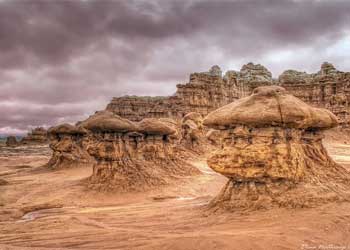The Valley

Goblin Valley State Park is a state park of Utah, USA. Its eminent feature is its thousands of hoodoos and hoodoo rocks, referred to locally as "goblins", which are formations of mushroom-shaped rock pinnacles, some as high as several meters. The distinct shape of these rocks comes from an erosion-resistant layer of rock atop softer sandstone.The park lies within the San Rafael Desert southeast of the east limb of the San Rafael Swell and north of the Henry Mountains. Utah State Route 24 passes about four miles east of the park. Hanksville lies 12 miles to the south. Hiking is permitted in the park, which features three marked trails.
Evidence of Native American cultures, including the Fremont, Paiute, and Ute, is common throughout the San Rafael Swell in the form of pictograph and petroglyph panels. Goblin Valley is noted for several rock art panels as well as the rock formations. The secluded Goblin Valley was then found by cowboys searching for cattle. Then in the late 1920s, Arthur Chaffin, later owner/operator of the Hite Ferry, and two companions were searching for an alternate route between Green River and Caineville. They came to a vantage point about 1 mile (1.6 km) west of Goblin Valley and were awed by what they saw: five buttes and a valley of strange goblin-shaped rock formations surrounded by a wall of eroded cliffs. In 1949 Chaffin returned to the area he called 'Mushroom Valley'. He spent several days exploring the mysterious valley and photographing its scores of intricately eroded rocks.
Publicity attracted visitors to the valley despite its remoteness. In 1954 it was proposed that Goblin Valley be protected from vandalism. The state of Utah later acquired the property and established Goblin Valley State Reserve. It was officially designated a state park on August 24, 1964.



